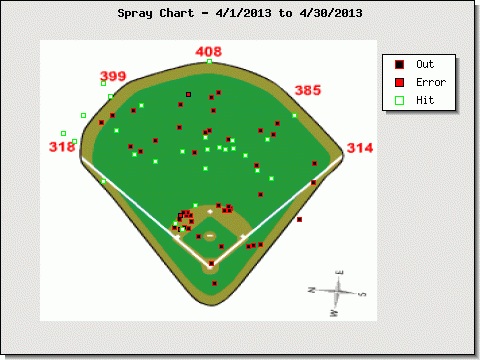As expected, the Yankees have officially released outfielder Vernon Wells. He was designated for assignment last week to clear a 40-man roster spot for Matt Thornton. No team claimed Wells and his massive salary off waivers (unsurprisingly), so any club can now sign him for the pro-rated portion of the league minimum. The Yankees still owe him $2.4M minus whatever his next team pays him.
Update: Yankees announce Matt Thornton signing
4:14pm: The Yankees have officially announced Matt Thornton’s two-year contract and confirmed Wells has been designated for assignment.
1:16pm: According to his Twitter feed, the Yankees have cut ties with Vernon Wells. Buster Olney says he was designated for assignment. The Yankees need 40-man roster space for both Brian Roberts and Matt Thornton and this clears one spot. Wells, 35, hit .233/.282/.349 (70 wRC+) last season and although he would have counted as $0 against the luxury tax in 2014, the team still owes him $2.4M in real dollars. The Angels owe him $18.6M.
What Went Wrong: Vernon Wells
The 2013 season is over and we’ve had a week to catch our breath. It’s time to review all aspects of the year that was, continuing today with the Yankees’ ill-advised outfield pickup.
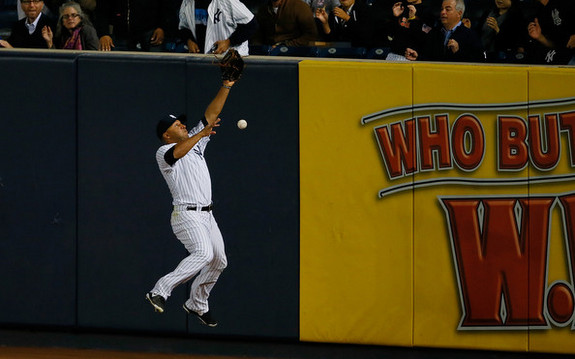
The Yankees traded for Vernon Wells at the end of Spring Training and paid him $11.5M this past season. On purpose. Despite a .222/.258/.409 (82 wRC+) batting line in 791 plate appearances for the Angels from 2011-2012, someone in the front office looked at Wells and thought he would be a good use of a roster spot and tens of millions of dollars. Desperation makes people do weird, weird things.
Injuries had taken their told on the Yankees even before Opening Day arrived. Derek Jeter and Alex Rodriguez had offseason surgeries delay the starts of their seasons while Curtis Granderson and Mark Teixeira got hurt in camp. Add in Nick Swisher leaving as a free agent, and the Bombers lost five of their six best hitters from last season without importing adequate replacements. That’s how you wind up trading for a guy like Vernon Wells. Desperation.
Amazingly, Wells actually made the Yankees look good for the first few weeks of the year. He hit .300/.366/.544 (148 wRC+) with six homeruns in April and legitimately belonged in the middle of the order. Against righties, against lefties, whatever. Wells was an everyday player and a big reason why the club exceeded expectations for the first 50 games or so. It looked like the pro scouting department had found another gem like Eric Chavez or Bartolo Colon, the guy with something left after everyone wrote him off.
But, of course, it didn’t last. I mean, it really didn’t last. There was no gradual decline, no steady slide back to Earth. Vernon just fell right off in the middle of May and stopped hitting all together. He just … stopped. Rollover grounder to short after rollover grounder to short, that’s what followed. It was unlike anything I’ve ever seen before. Healthy players — maybe Wells was nursing an injury, who knows? — just don’t stop hitting like that. Here, look:
That’s what it looks like when a hitter goes from really really good to really really bad in a heartbeat. Wells hit a homer on May 15th to raise his season batting line to .301/.357/.538 in 157 plate appearances, but his next 157 plate appearances? How about a .185/.204/.225 batting line. It didn’t stop there though. After hitting that homer on May 15th — his tenth of the season — Wells put up a .199/.243/.253 line with one (!) homer in his final 301 plate appearances of the year. One homer! It wasn’t even a real homer either. Look at this thing:
Hit Tracker says that homer traveled 344 ft. and would have been out in exactly one ballpark — Yankee Stadium. Vernon hit one dinger in his final 300 or so plate appearances and it bounced off the top of the wall of the shortest right field porch in baseball. Unbelievable.
Relegated to platoon status by the end of the season (even that was generous on Joe Girardi’s part), Wells hit .233/.282/.349 (70 wRC+) with eleven homers in 458 plate appearances this summer. That includes a .269/.318/.379 (89 wRC+) line in 198 plate appearances against left-handed hitters, so he didn’t even have much platoon value. On top of all of that, Wells was downright Andruw Jones-esque in the outfield, with little range and half-hearted retrieval skills. The total package was sub-replacement level (-0.2 bWAR and -0.8 fWAR) for the low price of $11.5M.
Big league teams know more about stuff than fans ever will, but every so often a move is made that is just so head-scratching and obviously bad. The Yankees asked Wells to buck two years of terrible performance and paid good money to do it. I guess the good news is that because of the way the money in the trade is structured, Vernon will count $0 against the luxury tax in 2014. The team still owes him $2.4M in real dollars though, so it’s not like he’s free. Wells was awful for two straight years before coming to New York and he made it three straight in pinstripes. I just don’t know why anyone expected otherwise.
Mailbag: Hughes, Soriano, Wells, Konerko
Got five questions for you today. If you want to send us anything throughout the week, the Submit A Tip box in the sidebar is the way to go.
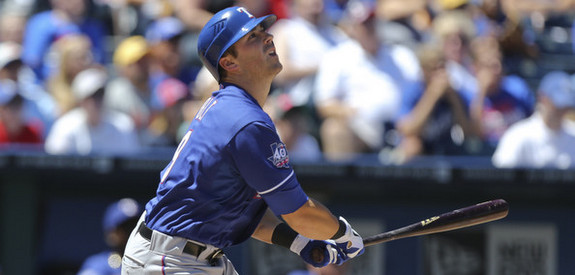
Alex asks: Guys, do you think that with the haul the Cubs got for Matt Garza, the Yankees could reasonably expect to obtain a Mike Olt type of prospect for Phil Hughes? Obviously the package would be less than what the Cubs got for Garza, but using the framework, could the Yankees get a pretty solid return for Hughes?
Olt, whose stock is down quite a bit this year, ranked 44th on Baseball America’s midseason top 50 prospects list. I like him less than that and think he’s more of a 75-100 prospect, but my opinion doesn’t matter. Teams have their own internal evaluation of every player and that’s most important.
Pitchers similar to Hughes — that means a back of the rotation starter due to become a free agent — who have been traded at the deadline in recent years include Ted Lilly, Joe Saunders, Joe Blanton, Jason Marquis, Erik Bedard, and Jake Westbrook. Hughes is by far the youngest of the group, but age doesn’t really matter when you’re talking about a three-month rental.
The trade return for those guys ranges from a big league reliever (Saunders for Matt Lindstrom), one good but not great pitching prospect (Westbrook for Corey Kluber), four fringe prospects (Bedard), a promising young big leaguer (Lilly for Blake DeWitt), and a borderline non-prospect (Blanton). No one on par with Olt, obviously.
This is a seller’s market though, mostly because more teams are in contention thanks to the second wildcard and no one wants to sell. If you have an asset like a back-end starter, you might be able to fetch more than expected. An Olt-caliber prospect is probably the best-case scenario for Hughes. I do think the Yankees are going to keep him unless they get a legit big league bat in return, however.
John asks: Who is considered — at this point in their respective careers — a better defender in left field, Alfonso Soriano or Vernon Wells?
Soriano was a complete disaster in left field when he first made the transition from second base, but he’s worked really hard to improve out there over the years. Experience helps as well. UZR has rated him a bit above-average in recent years while DRS has him a bit below-average. I prefer DRS personally, but the truth is probably somewhere in the middle. I don’t watch enough Cubs games to say if one jibes with the eye test more than the other.
Wells was never as good as his reputation as a Gold Glover, but both UZR and DRS agree that he’s been ever so slightly above-average in the field since shifting to left three years ago. He’s graded out as below-average in center for a half-decade now. I’ve been pretty underwhelmed with Wells’ defense, particularly his range, but I suppose it is better than the typical left fielder. Defensive stats aren’t precise enough to argue over fractions of a run and whatnot, and at this point I think Vernon’s the better defensive left fielder. Not by a ton though.
Jeremy asks: Hey Mike, what about Paul Konerko? Tradeable, right-handed, free agent next year…
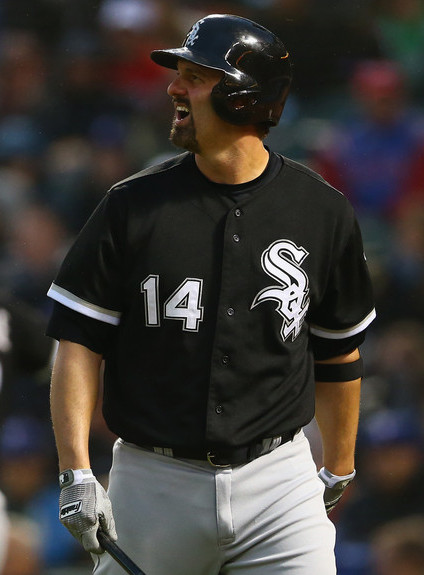
Joe had a Konerko kick for a few weeks a while back, but I would go nowhere near him. For starters, Konerko has been dealing with some nagging back problems this summer, at one point receiving six (!) injections. Back trouble for older players (he’s 37) is a total dealbreaker for me.
If that wasn’t enough, Konerko really isn’t hitting this year. He’s at .248/.315/.365 (84 wRC+) with seven homers in 295 plate appearances, though he does have a stellar 149 wRC+ against southpaws in limited time. The strikeouts are up (15.3%), the walks are down (8.2%), the power is gone (possible related to the back trouble) … lot of red flags here. If Konerko was hitting like he did last year (26 homers and 132 wRC+), I’d be all for it. At this point I’m staying far away.
Chris asks: Much has been made of teams handing out monster contracts lately, primarily because the term comes back to bite teams in the long run. Could the solution to this be not allowing teams to control players for longer but shorter? Would MLB and the players union be willing to allow free agency after six years from the draft or two years on a team’s 25-man roster (whichever comes first)?
Baseball’s salary structure is very … weird. Players make the least amount of money during what is usually their best years — their first six seasons, during pre-arbitration and arbitration — and the most when they’re on the decline. The MLBPA would absolutely be in favor of anything that moves free agency up, which means the owners would be very much against it. They only like things that keep costs down. Small market teams would have a hard time competing if their best players could leave after two years. It would be impossible, really.
The only “solution” to prevent getting burned by long-term contracts is to not hand them out. Even if you moved free agency up, teams would still overpay for decline years. That seem inevitable. Whenever a huge contract is handed out, like seven or eight years, a lot of times the GM is assuming he won’t be around for the final few years of the deal, when it tends to go really bad. Many of these contracts are handed out with the idea that the worst part will be someone else’s problem. I have very little pity for clubs who get saddled with a long-term deal gone bad. They make their beds, they have to sleep in it.
Mark asks: Do the Yanks need make it priority #1 to acquire a long-term solution at third base this offseason (or before the trading deadline) as it is all but assumed that Alex Rodriguez will be banned for either 150 games or permanently starting either now or next year? Or is it another year of stop-gap temporary players and pray that either A-Rod is back at age 38/39 and that Eric Jagielo is hopefully ready by the 2015 season?
The Yankees shouldn’t count on Jagielo at all when planning the future of the third base position. He was just drafted and even though he’s polished and expected to climb the ladder quickly, he’s still in short season ball and so very much can go wrong before be makes it to the show. It’s the nature of the beast.
I think priority #1 should be finding a long-term shortstop, but third base is pretty much priority #2. This season confirmed it. They can’t count on A-Rod anymore and there are no real third base prospects on the immediate horizon, so they’ll have to look outside the organization. Finding that young guy to hold down the position for the next half-decade won’t be easy, so they’ll probably have to settle on stopgaps for the time being. Hopefully none with chronic back problems this time. Who knows, maybe Jagielo will emerge before they make any kind of trade for a long-term answer.
2013 Midseason Review: Grade D’s
We’ve spent some time dissecting the team’s performance through the first half of the year. Mike wrote about the A’s, the B’s, and the C’s. Notice he left me with the scrubs – the D’s!* Well, at least the D’s aren’t the F’s. Am I right?

David Phelps
I know some of you might protest our decision to give Phelps a “D” grade. Whether you’re lobbying to give him a “C” doesn’t make much of a difference though — it doesn’t change reality. He’s not been great overall despite some solid starts. It’s also funny, in a peculiar kind of way, how quickly the shine wears off of a guy.
Anyway, Phelps has pitched to a 5.01 ERA (3.85 FIP) and has been worth 1.1 fWAR thus far. He’s struck guys out at a decent rate (8.17 K/9) and hasn’t given up too many long balls (0.87 HR/9). Phelps has allowed a few too many free passes though (3.48 BB/9) and gives up more hits throughout his starts than one would ideally prefer.
Consistency has been the issue here. Despite several quality starts, Phelps has seen his numbers balloon thanks to some really awful games (particularly of late). He allowed four earned runs in 6.1 innings against Minnesota, nine runs against Baltimore (in 2.1 innings!), and four runs to the Mets in a third of an inning. On one hand you can look at Phelps a bit less critically when you consider that he is and always was expected to be a back of the rotation type of arm. One other hand, results are results. Sorry, David.
Phil Hughes
Getting tired of reading about Phil Hughes yet? Well, we all know the story here – frustrating inconsistency topped off by too many home runs surrendered (1.58 HR/9, here’s the list of pitchers with the most HR surrendered — good to know the Yankees have two guys cracking the top 15). Through 102.1 innings, Hughes has pitched to a 4.57 ERA (4.48 FIP), and has been valued at 0.9 fWAR. In terms of peripherals, he’s striking out 7.74 batters per nine and has limited the walks (2.29 BB/9).
Despite very legitimate concerns over next year’s rotation, it seems pretty clear the Yankees are willing to part ways with the once-heralded Hughes. If they don’t trade him for a bat by the deadline, they’ll give him the qualifying offer after the season, which he probably won’t accept. The funny thing is, as maddening as Hughes has been, he’s still capable of throwing the occasional gem and should he string together some solid starts through the remainder of the season, you know some team will decide he’s worth committing a lot of dollars and several years too. It’s a shame it hasn’t really worked out in New York but that’s how it goes sometimes.
Chris Stewart
This is a tough break for Chris. He’s basically producing at a reasonable level, I argue … for a backup catcher. The problem is he isn’t a backup catcher. After the Yankees elected to forego Russell Martin for Francisco Cervelli, the most obvious predicament in the world occurred. Cervelli was injured and the team had to figure out where to go from there. That’s when Chris Stewart stepped in as the every day guy.
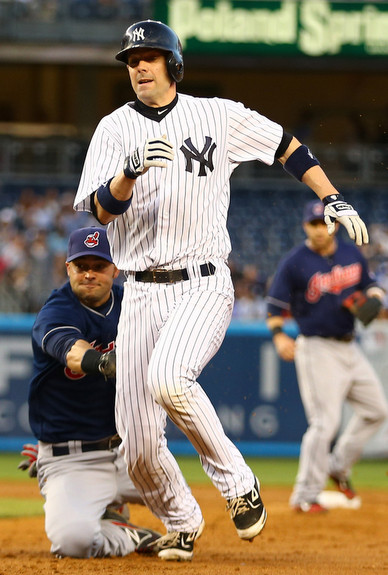
So what happens to a guy like Chris Stewart when he’s forced to play day in and day out? Well over 197 plate appearances he’ll hit .241/.316/.306 (.282 wOBA, 77 wRC+, 0.8 fWAR). He’ll take a decent number of walks (9.1 BB%) and will put the ball in play frequently (14.2 K%). He’ll also hit for no power whatsoever (three home runs, 0.65 ISO). Defensively, I think he’s generally regarded favorably. Again, I would argue that none of these stats are necessarily bad, they’re just not good.
To put it in perspective, the Yankees catchers collectively rank twentieth in all of baseball in terms of fWAR (1.1), twenty-fourth in wRC+ (68), and twenty-fifth in wOBA (.275). Obviously, not all of this production is Stewart’s doing, though he’s logged far and away the most innings behind the plate. Basically, the production the Yankees have received from their catchers ranks in the bottom third of all of baseball in just about every meaningful category.
Vernon Wells
Remember when Wells hit .300 with six home runs through April? Remember when folks were wondering whether Cashman was actually a genius for taking on one of the worst contracts in all of baseball? Yep, that didn’t last long. In completely predictable fashion, Wells turned back into the pumpkin he’s been for years — that is to say a grossly overpriced fourth outfielder.
Overall, Big Vern has batted .238/.276/.371 (.282 wOBA, 73 wRC+, 0.1 fWAR). On the plus side, he’s been generally pretty good in the outfield defensively despite a few questionable plays of late. On the down side, he’s managed to hit only four home runs since April. He’s also hit in the heart of order basically all season, even during his putrid May slump.
Given the amount of exposure he’s seen thus far, it’s not surprising he’s shown noticeable splits either (batting .207 against righties). Back in late May, I wrote about Vernon and what we could expect moving forward. Long story short, the conclusion was that he most certainly wasn’t the player we saw in April, and hopefully also not the guy we saw in May. I think this still holds true. Unfortunately, what we can expect is a “D grade” player who was brought to the team out of necessity. Hopefully, he’ll be used more sparingly going forward when and if Curtis returns.
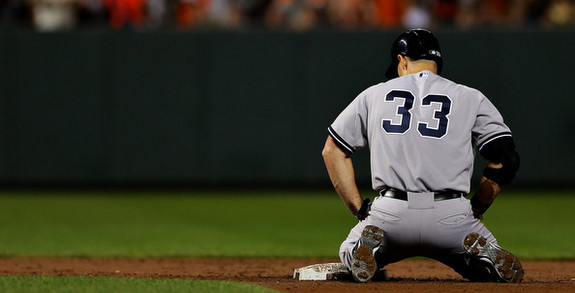
Travis Hafner
First, let me start by saying that I for one am shocked that Hafner has made it to this point. I was expecting Pronk to pull a Kevin Youkilis and suffer some season-ending injury after the first month or so. Surprisingly, he has generally kept himself in the lineup despite some nagging injuries here and there (most recently a foot contusion that happened during batting practice). Unfortunately (and much like Wells), Hafner has been lousy since May and he too, has shown noticeable splits as to be expected.
Overall, Pronk’s batting .218/.314/.407 (.317 wOBA, 97 wRC+) and has been worth exactly 0.0 fWAR through 277 plate appearances. He has knocked 12 balls out of the park though, which is second on the team to only Robinson Cano (though Lyle Overbay and Wells are right behind him with 11). Hafner continues to take his fair share of walks (11.2 BB%) while striking out at a fair pace (26.0 K%).
Pronk was brought on board for one thing: his job is to mash. The thinking was simple. As long as he’s healthy (or at least relatively healthy), he’ll hit the ball. This hasn’t really been the case though. He’s struggled a lot. He’ll need to turn it around for the rest of the season as the Yankees need some much needed depth in the batting the order.
*Mike did not stick me with the D’s. It just worked out that way because of timing. Actually, I claimed the F’s too.
The inevitable Vernon Wells discussion begins

The Yankees 2013 offseason was “interesting,” to say the least. It involved a couple big names departing to greener pastures Pittsburgh and Cleveland, and several apparent retreads joining the NY ranks in their stead.
Among these acquired castoffs was Vernon Wells, who the Yankees — in seeming desperation — elected to pay $13.9M over the course of the next two seasons (though the bulk of the money owed was front-loaded to 2013). This was despite Vernon’s rash of injuries and meager .258 on-base percentage over the prior two seasons (apparently his 2011 .248 OBP was the lowest among all outfielders with at least 500 plate appearances since 1904 … so there’s that). To put it mildly, most of us had our doubts about the deal on a lot of levels.
However, as John Sterling and Suzyn Waldman vehemently claim, “You simply cannot predict baseball!” Wells had recovered from his varying ailments (a torn ligament in his right thumb most notably), he focused on improving his offensive production by applying a shorter, more direct swing — all of which would presumably be enhanced by the hitter-friendly confines of Yankee Stadium.
By mid-April, Vernon was batting in the heart of the order to the tune of .300/.366/.544 with six home runs. He was looking like a rejuvenated version of his former self and an early Comeback Player of the Year candidate — all while inadvertently making Cashman look less like a ninja and more like a genius.
May has been somewhat of a different story though. Consider the grid below, compliments of Baseball-Reference.
| Split | G | GS | AB | R | H | 2B | 3B | HR | SB | CS | BB | SO | GDP | tOPS+ | sOPS+ | |||||
|---|---|---|---|---|---|---|---|---|---|---|---|---|---|---|---|---|---|---|---|---|
| 2013 Totals | 49 | 46 | 186 | 24 | 49 | 6 | 0 | 10 | 4 | 2 | 14 | 29 | .263 | .313 | .457 | .770 | 4 | .264 | 100 | 112 |
| Last 7 days | 5 | 5 | 22 | 0 | 2 | 0 | 0 | 0 | 0 | 1 | 0 | 4 | .091 | .091 | .091 | .182 | 1 | .111 | -51 | -49 |
| Last 14 days | 11 | 10 | 43 | 3 | 6 | 2 | 0 | 0 | 0 | 1 | 1 | 9 | .140 | .159 | .186 | .345 | 1 | .176 | -8 | -4 |
| Last 28 days | 24 | 22 | 92 | 10 | 21 | 2 | 0 | 4 | 2 | 2 | 4 | 14 | .228 | .260 | .380 | .641 | 2 | .230 | 66 | 76 |
The numbers aren’t pretty, which is particularly hard to stomach considering he’s the guy often times backing up Robinson Cano in the lineup. A quick glance at Vernon’s April and May spray charts (provided by Texas Leaguers) confirms what our eyes have witnessed these past few weeks: he’s been hitting into far more ground outs in May (23%) then he did in April (12.87%). There have been far more ground outs hit towards the second baseman as well than there were last month – so it’s not like he is getting overly pull happy either (not that that would necessarily help him in NY).
In terms of the ground outs, it’s possible some of his May struggles have been exasperated by an atrocious BAbip (considering his career norm is .279). I’m leery of over-simplifying BAbip to the term “luck,” but regardless of how one wants to define the stat, Vernon has certainly not been the benefactor. Even if his stats do regress to what we’ve seen over the past few seasons from him, Vernon’s BAbip would still qualify as unusually low. Eventually, some of these balls should get through the defense. And considering that his recent struggles are by very definition inherently limited in sample size, it wouldn’t take much to get those numbers moving back in the right direction.
For what it’s worth, Texas Leaguers shows us that opposing pitchers will have thrown approximately the same amount of fastballs (fastballs including both two and four-seamers, cut fastballs, and split-fingered fastballs) by month’s end as they did in April. As to be expected, the vast majority of the fastballs seen were four seamers, and in that particular category he’s been proportionately only a few percentage points less effective at putting the ball in play in May (24.5%) than he was in April (29.6% in play) — nothing super drastic — though it is worth noting that opposing pitchers have been throwing more for strikes this month than last. The problem is the balls he is making contact with are simply not being hit well.
Anecdotally, there is also the possibility that his stance has opened up a bit again, thus resulting in longer swings. This would result in less time to see (and swing at) the pitch, which could explain the uptick in weaker ground outs. Perhaps he needs to re-explore the adjustments he made in the offseason. If he’s not seeing the pitches as well, it’d make sense that he’d be hitting the ball with less conviction more often. This could be the kind of “quick fix” solution that resolves itself overnight. Unfortunately, that’s also the type of mechanical flaw that I’m sure both he and Kevin Long are constantly watching for and are proactively trying to prevent. It also strikes me as weird that he could go suddenly to different ends of the spectrum against a certain type of pitch.
So where does this leave us? Has Vernon turned back into the pumpkin (or worse) that most of us expected from day one, or is this just an unfortunate slump (that is being brought to attention a bit more than it probably should be given the team’s overall offensive struggles of late)? Frankly, it’s too soon to make any meaningful conclusion. At this juncture, this is merely an observation that’s worth keeping an eye on. If we find ourselves watching a still-struggling Wells come the All Star break, we’ll probably know where things are heading though. In the meantime, let’s hope get can keep it together at least until Curtis Granderson’s able to return.
Wells’ slump comes at worst possible time
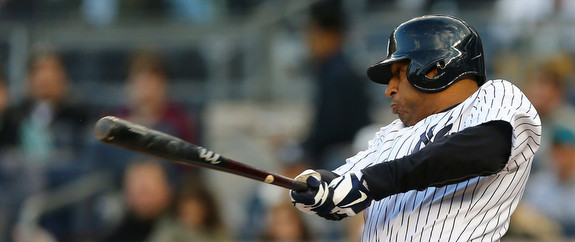
Like many of you, I was extremely skeptical when the Yankees acquired Vernon Wells for two non-prospects at the very end of Spring Training. The move stunk of desperation, but frankly the team was desperate at that time. They lost a lot of offense to injury in the prior weeks and something had to be done. The Angels had a player they wanted the dump and the Yankees had a need. The puzzle pieces fit.
Wells, 34, made the Yankees look very smart for the first few weeks of the season. He had three hits, including a homer, against the Red Sox during the second game of the season. Two days later he went deep again, and the homers kept coming — five in his first 15 games of the year. Wells finished April with a .300/.366/.544 (145 wRC+) batting line that exceeded every reasonable expectation. It was just what the Yankees needed.
Things haven’t been going so well for Vernon since then, however. Last night’s 0-for-4 dropped him to 3-for-21 (.143) on the month and 10-for-48 (.208) in his last 13 games. That dates back to the series in Toronto, when he bludgeoned his former team for three days. Wells is still hitting a respectable .270/.328/.468 (114 wRC+) on the season, but he has clearly been trending downward of late. Anecdotally, it seems like he’s been getting beat on a lot of outside pitches lately. Both fastballs and breaking balls. The strike zone plots do not show that he’s been getting more outside pitches of late, however (via Texas Leaguers):

Who knows why the slump is happening, but it’s happening. Maybe he’s just fatigued from playing everyday for the first time in two years. The slump shouldn’t be unexpected either, Wells was hitting far better than he did even during his prime last month. At some point he was going to cool off.
The unfortunate thing is that the Yankees need Wells to hit right now, very much so. With Kevin Youkilis injured and, for at least three games, Travis Hafner limited to pinch-hitting duties in the NL park, there needs to be someone in the lineup to complement Robinson Cano. As good as he is, Robbie can’t do it all by himself. Brett Gardner and Ichiro Suzuki have been doing a fine job of getting on-base of late, but someone other than Cano needs to drive them in. Wells has to be that guy and right now he isn’t.
At some point Vernon will heat back up and go on a nice tear. At least I think he will. It is fair to be skeptical of him going forward given how dreadful he’s been the last two years, but I don’t think he’s suddenly regressed to sub-replacement level. The question is when will that rebound happen? Outside of Curtis Granderson and maybe Youkilis, the Yankees are unlikely to get any of their injured bats back this month. Their offense simply isn’t good enough to get by with a slumping Wells. He gave them more than they could have asked for in April, but now they need him to do more in May.

